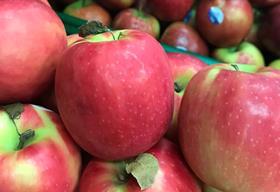
This year’s European apple crop will be lower than official estimates and there will be a notable lack of larger sizes favoured by markets such as Italy and Spain, according to one of the continent’s leading marketers.
Gerhard Dichgans, director of Italian consortium Vog, said that in all likelihood the anticipated volume of 9.3m tonnes – a 21 per cent decrease on the previous year’s crop and the lowest in a decade – would not be achieved.
“The losses caused by the spring frost are huge,” he insisted. “What’s more, during the last few weeks, bad weather and hailstorms have aggravated the already serious damage, and unfortunately this also applies to the Alto Adige region.”
At the end of July, Vog estimated its eating apple crop for 2017/18 would be around 570,000 tonnes, 10 per cent lower than its volume for the previous season, but that has since been revised.
“After the hailstorms in the first week of August, we now have to reduce this estimate by 70,000 tonnes, giving us 500,000 tonnes, or 20 per cent [less] compared to the 2016 crop,” Dichgans explained.
The reduction in the size of the group’s crop is reflected in decreases for all of its traditional varieties, with falls of 15 per cent predicted for Royal Gala, Red Delicious and Morgenduft, and 10 per cent for Granny Smith.
The worst hit, Dichgans reported, are Golden Delicious (-35 per cent) and Braeburn (-25 per cent). The only exception is Fuji, which will match the what were described as poor figures for 2016.
Clubbing together
For club apple varieties, however, Vog’s production is expected to be more or less in line with the previous year’s volume.
Pink Lady and Jazz volumes are both forecast to estimated to fall by 10 per cent, while volumes for Kanzi and Envy will be the same as in 2016 thanks to the new orchards planted in previous years.
“The Royal Gala harvest began on the weekend of 12-13 August, with the first shipments scheduled for the third week of the month,” Dichgans continued. “About one third of this variety has now been harvested. The temperatures have finally dropped during the last few days, and the cooler nights have enabled the fruit to colour up well.”
He said it was still too early to provide precise figures. “What matters now is to pick the apples with the right degree of ripeness, within the harvesting window recommended by the technical experts.
“The important thing is the fruit’s internal quality, which ensures the keeping properties and shelf-life our customers want. Unfortunately, there is one serious drawback: a shortage of the large fruit sizes in demand on the Italian and Spanish markets.”
“The August market will get off to a fairly slow start,” Dichgans added, “but in autumn, when harvesting is complete, players will become aware of the real figures for the 2017 crop, especially on our two most important markets, Italy and Germany, where there will be a shortage of the two leading varieties, Golden Delicious and Jonagold respectively.
“Obviously, in the second part of the season this will be reflected in apple prices, which have already been on the move for several months.”
He concluded: “The growers hit by the spring frosts and this summer’s hailstorms will not find much to be cheerful about in this new apple harvest. But the essential factor is this: balance is being restored to the market and - from this point of view - things are looking up for our growers.”



